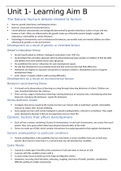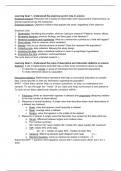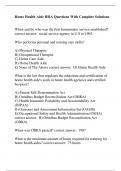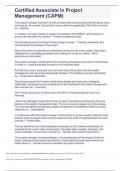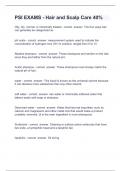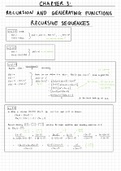Unit 1- Learning Aim B
The Nature/ Nurture debate related to factors
Nature: genetic inheritance and biological factors.
Nurture: social and environmental factors.
Certain physical characteristics are biologically determined by genetic inheritance (colour of eyes and hair,
texture or hair). Other are influenced by the genetic make-up of the birth parents (height, weight, life
expectancy, vulnerability to certain diseases).
Psychological characteristics such as behavioural tendencies, personality traits and mental abilities are either
influenced by genetics or the environment.
Development as a result of genetic or inherited factors
Gessel’s maturation theory
Arnold Gesell looked at children’s biological maturation in the 1940-50s.
He developed the normative approach which involved observing large numbers of children to find the skills
and abilities that most children had in each age group.
He established the norms/ milestones for each development aspect.
He said that development was predetermined and that environmental had little difference.
Milestones are helpful for educators and parents to measure children’s development and to recognise
development delay.
Critic- doesn’t consider children with learning difficulties.
Development as a result on environmental factors
Bandura’s social learning theory
It is based on his observations of learning occurring through observing behaviour of others. Children can
copy unwanted behaviour like violence.
There are four stages of behavioural learning: noticing behaviour of someone else, remembering what they
observed, reproduce the behaviour, repeat the behaviour
Stress-diathesis model
It explains how stress caused by life events (nurture) can interact with an individual’s genetic vulnerability
(nature) to impact their mental wellbeing.
Some people are born with certain biological or genetic predispositions, referred to as diathesis. They might
never develop the disorder if they do not experience stress in their life.
Genetic factors that affect development
Each cell has a nucleus containing 23 pairs of chromosomes. In each pair chromosome, one comes from each
parent. They carry genes which determine physical characteristics of the child.
Genes are made up of DNA, which contains instructions for producing proteins that regulate development.
Genetic predisposition to particular conditions
Genetic predisposition is the possibility that you may inherit a certain condition from one or both your
parents. But it doesn’t mean that it is a certainty that you will develop that condition.
Cystic fibrosis
Caused by a faulty gene that affects the movement of salt and water in and out of cells.
A person with this condition is born with it.
It causes sticky mucus to build up in the lungs and digestive system.
Symptoms: recurring chest infections, wheezing, coughing, shortness of breath, jaundice, constipation,
difficulty putting on weight and growing.
, These is no cure, but treatment is available to control symptoms caused.
Brittle bones disease
It is caused by a defect in a gene that is inherited from parents.
It results in fragile bones that break easily.
Symptoms: bone deformities, broken bones, loose joint, weak teeth, bowed legs and arms, kyphosis,
scoliosis, heart defects and respiratory problems.
It can cause hearing loss, heart failure, spinal cord problems and permanent deformities.
There is no cure, but treatment available to help control the symptoms (physical therapy, medicine to
reduce pain, exercise)
Phenylketonuria (PKU)
They can’t break down the amino acid phenylalanine, which then builds up in the blood and brain and can
lead to brain damage.
It is inherited when a gene mutates and is passed on from the parents. It is recessive.
Symptoms: behavioural difficulties, fairer skin, eye and hair than siblings without conditions, eczema,
epilepsy and recurring vomiting.
The main treatment is a low- protein diet that completely avoids high-protein foods and controls the intake
of other foods and amino acid supplements.
Huntington’s disease
A condition that stops parts of the brain working properly over time.
It is caused by a faulty gene that either one or both parents carry this faulty gene (dominant).
Symptoms: difficulty concentrating and memory lapses, depression, stumbling and clumsiness, mood swings
and personality changes, difficulty moving and problems swallowing, speaking and breathing.
There is no cure, but medicine is given to reduce the problems it causes. Medicine for depression, mood
swings and involuntary movements, occupational therapy, speech and language therapy and physiotherapy.
Klinefelter’s syndrome
It is a syndrome where boys are born with an extra x chromosome when a mother’s egg or father’s sperm
has the extra chromosome. (XXY instead of XY)
Symptoms: learning to sit up, crawl, walk and talk later than usual, shyness and low self-confidence,
problems with reading, mild dyslexia, growing taller than expected for the family, inability to have children
naturally.
There is no cure but there are treatments for the problems is causes. (Testosterone replacement therapy,
speech and language therapy)
Down’s syndrome
It is caused by an extra chromosome in a baby’s cells. It is the result of a one-off genetic change is the sperm
or egg.
Characteristics: slower to learn skills like sitting, standing, walking and talking.
Complications: high risk of heart conditions, hearing and vision problems, thyroid conditions and infections
like pneumonia.
Colour blindness
It is an inherited colour vision deficiency as a result of an abnormality in the retina.
It can be experienced as a result of diabetes and multiple sclerosis or because of the ageing process or side
effects to certain types of medication.
It doesn’t normally lead to long-term health problems.
Duchenne muscular dystrophy
A group of inherited genetic conditions that gradually weaken muscles and it worsens over time.
It is inherited on a female gene (X chromosome) and is passed only to male offspring.
It is a condition with muscle weakness mainly in muscles around the hips and shoulders. Their hands and
fingers are less affected
Survival beyond the age of 30 is rare.
The Nature/ Nurture debate related to factors
Nature: genetic inheritance and biological factors.
Nurture: social and environmental factors.
Certain physical characteristics are biologically determined by genetic inheritance (colour of eyes and hair,
texture or hair). Other are influenced by the genetic make-up of the birth parents (height, weight, life
expectancy, vulnerability to certain diseases).
Psychological characteristics such as behavioural tendencies, personality traits and mental abilities are either
influenced by genetics or the environment.
Development as a result of genetic or inherited factors
Gessel’s maturation theory
Arnold Gesell looked at children’s biological maturation in the 1940-50s.
He developed the normative approach which involved observing large numbers of children to find the skills
and abilities that most children had in each age group.
He established the norms/ milestones for each development aspect.
He said that development was predetermined and that environmental had little difference.
Milestones are helpful for educators and parents to measure children’s development and to recognise
development delay.
Critic- doesn’t consider children with learning difficulties.
Development as a result on environmental factors
Bandura’s social learning theory
It is based on his observations of learning occurring through observing behaviour of others. Children can
copy unwanted behaviour like violence.
There are four stages of behavioural learning: noticing behaviour of someone else, remembering what they
observed, reproduce the behaviour, repeat the behaviour
Stress-diathesis model
It explains how stress caused by life events (nurture) can interact with an individual’s genetic vulnerability
(nature) to impact their mental wellbeing.
Some people are born with certain biological or genetic predispositions, referred to as diathesis. They might
never develop the disorder if they do not experience stress in their life.
Genetic factors that affect development
Each cell has a nucleus containing 23 pairs of chromosomes. In each pair chromosome, one comes from each
parent. They carry genes which determine physical characteristics of the child.
Genes are made up of DNA, which contains instructions for producing proteins that regulate development.
Genetic predisposition to particular conditions
Genetic predisposition is the possibility that you may inherit a certain condition from one or both your
parents. But it doesn’t mean that it is a certainty that you will develop that condition.
Cystic fibrosis
Caused by a faulty gene that affects the movement of salt and water in and out of cells.
A person with this condition is born with it.
It causes sticky mucus to build up in the lungs and digestive system.
Symptoms: recurring chest infections, wheezing, coughing, shortness of breath, jaundice, constipation,
difficulty putting on weight and growing.
, These is no cure, but treatment is available to control symptoms caused.
Brittle bones disease
It is caused by a defect in a gene that is inherited from parents.
It results in fragile bones that break easily.
Symptoms: bone deformities, broken bones, loose joint, weak teeth, bowed legs and arms, kyphosis,
scoliosis, heart defects and respiratory problems.
It can cause hearing loss, heart failure, spinal cord problems and permanent deformities.
There is no cure, but treatment available to help control the symptoms (physical therapy, medicine to
reduce pain, exercise)
Phenylketonuria (PKU)
They can’t break down the amino acid phenylalanine, which then builds up in the blood and brain and can
lead to brain damage.
It is inherited when a gene mutates and is passed on from the parents. It is recessive.
Symptoms: behavioural difficulties, fairer skin, eye and hair than siblings without conditions, eczema,
epilepsy and recurring vomiting.
The main treatment is a low- protein diet that completely avoids high-protein foods and controls the intake
of other foods and amino acid supplements.
Huntington’s disease
A condition that stops parts of the brain working properly over time.
It is caused by a faulty gene that either one or both parents carry this faulty gene (dominant).
Symptoms: difficulty concentrating and memory lapses, depression, stumbling and clumsiness, mood swings
and personality changes, difficulty moving and problems swallowing, speaking and breathing.
There is no cure, but medicine is given to reduce the problems it causes. Medicine for depression, mood
swings and involuntary movements, occupational therapy, speech and language therapy and physiotherapy.
Klinefelter’s syndrome
It is a syndrome where boys are born with an extra x chromosome when a mother’s egg or father’s sperm
has the extra chromosome. (XXY instead of XY)
Symptoms: learning to sit up, crawl, walk and talk later than usual, shyness and low self-confidence,
problems with reading, mild dyslexia, growing taller than expected for the family, inability to have children
naturally.
There is no cure but there are treatments for the problems is causes. (Testosterone replacement therapy,
speech and language therapy)
Down’s syndrome
It is caused by an extra chromosome in a baby’s cells. It is the result of a one-off genetic change is the sperm
or egg.
Characteristics: slower to learn skills like sitting, standing, walking and talking.
Complications: high risk of heart conditions, hearing and vision problems, thyroid conditions and infections
like pneumonia.
Colour blindness
It is an inherited colour vision deficiency as a result of an abnormality in the retina.
It can be experienced as a result of diabetes and multiple sclerosis or because of the ageing process or side
effects to certain types of medication.
It doesn’t normally lead to long-term health problems.
Duchenne muscular dystrophy
A group of inherited genetic conditions that gradually weaken muscles and it worsens over time.
It is inherited on a female gene (X chromosome) and is passed only to male offspring.
It is a condition with muscle weakness mainly in muscles around the hips and shoulders. Their hands and
fingers are less affected
Survival beyond the age of 30 is rare.


